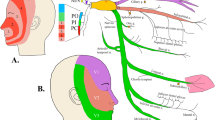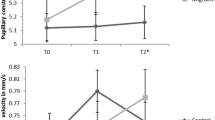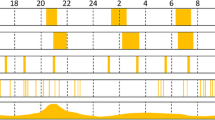Abstract
At least four neural mechanisms influence facial blood flow. Firstly, sympathetic vasoconstrictor fibres exert a tonic constrictor influence on the vasculature of the ears, lips and nose, and sparsely supply other parts of the face. Secondly, the sympathetic nervous system actively dilates the cutaneous vasculature of the face during heat stress and emotion. Thirdly, parasympathetic vasodilator reflexes in the facial and glossopharyngeal nerves increase blood flow to the exocrine glands and tissues of the eyes, nose and mouth when these tissues are irritated. Fourthly, axon reflexes release vasoactive peptides from sensory fibres, which participate in local inflammatory responses. The sympathetic nervous system normally controls facial sweating. However, after injury to postganglionic sympathetic fibres, parasympathetic fibres sometimes make functional connections with sweat glands, so that parasympathetic reflexes provoke pathological sweating. In this review, new information about the neural pathways and stimuli which influence facial sweating and blood flow is summarized, and this is followed by a discussion of the pathophysiology of extracranial vascular disturbances and facial sweating in migraine, cluster headache and harlequin syndrome.
Similar content being viewed by others
References
Nathan PW, Smith MC. The location of descending fibres to sympathetic neurons supplying the eye and sudomotor neurons supplying the head and neck.J Neurol Neurosurg Psychiatry 1986;49: 187–194.
Drummond PD, Lance JW. Pathological sweating and flushing accompanying the trigeminal lacrimal reflex in patients with cluster headache and in patients with a confirmed site of cervical sympathetic deficit: evidence for parasympathetic crossinnervation.Brain 1992;115: 1429–1445.
Goetz RH. The surgical physiology of the sympathetic nervous system with special reference to cardiovascular disorders.Int Abstracts Surg 1948;87: 417–439.
Luebke JI, Wright LL. Characterization of superior cervical ganglion neurons that project to the submandibular glands, the eyes, and the pineal gland in rats.Brain Res 1992;589: 1–14.
Flett DL, Bell C. Topography of functional subpopulations of neurons in the superior cervical ganglion of the rat.J Anat 1991;177: 55–66.
Gibbins IL. Vasomotor, pilomotor and secretomotor neurons distinguished by size and neuropeptide content in superior cervical ganglia of mice.J Autonom Nerv Syst 1991;34: 171–184.
Matthews B, Robinson P. The course of post-ganglionic sympathetic fibres distributed with the trigeminal nerve in the cat.J Physiol 1980;303: 391–401.
Mathews B, Robinson PP. The course of postganglionic sympathetic fibres distributed with the facial nerve in the cat.Brain Res 1986;382: 55–60.
Drummond PD, Lance JW. Facial flushing and sweating mediated by the sympathetic nervous system.Brain 1987;110: 793–803.
Nordin M. Sympathetic discharges in the human supraorbital nerve and their relation to sudo- and vasomotor responses.J Physiol 1990;423: 241–255.
Drummond PD, Lance JW. Extracranial vascular changes and the source of pain in migraine headache.Ann Neurol 1983;13: 32–37.
Iversen HK, Neilsen TH, Olesen J, Tfelt-Hansen P. Arterial responses during migraine headache.Lancet 1990;336: 837–839.
Nieison CP, Vestal RE.In vivo methods for studying adrenergic receptors. In: Insel PA, ed.Adrenergic Receptors in Man. New York: Marcel Dekker Inc, 1987: 1–35.
Gustafsson D, Andersson L, Martensson L, Lundvall J. Microsphere analysis of β2-adrenergic control of resistance in different vascular areas after hemorrhage.Acta Physiol Scand 1984;121: 119–126.
Nielson H, Thom SMcG, Hughes AD, Martin GN, Mulvany MJ, Sever PS. Postjunctional α2-adrenoceptors mediate vasoconstriction in human subcutaneous resistance vessels.Br J Pharmacol 1989;97: 829–834.
Mellander S, Andersson P, Afzelius L, Hellstrand P. Neural beta-adrenergic dilatation of the facial vein in man: possible mechanism in emotional blushing.Acta Physiol Scand 1982;114: 393–399.
Blair DA, Glover WE, Roddie IC. Cutaneous vasomotor nerves to the head and trunk.J Appl Physiol 1961;16: 119–122.
Fox RH, Goldsmith R, Kidd DJ. Cutaneous vasomotor control in the human head, neck and upper chest.J Physiol 1962;161: 298–312.
Drummond PD, Finch PM. Reflex control of facial flushing during body heating in man.Brain 1989;112: 1351–1358.
Olsson P, Bende M. Sympathetic neurogenic control of blood flow in human nasal mucosa.Acta Otolaryngol 1986;102: 482–487.
Hashimoto M, Sommerlad U, Pleschka K. Sympathetic control of blood flow to AVAs and capillaries in nasal and facial tissues supplied by the internal maxillary artery in dogs.Pflug Arch 1987;410: 589–595.
Granstam E, Nilsson SFE. Non-adrenergic sympathetic vasoconstriction in the eye and some other facial tissues in the rabbit.Eur J Pharmacol 1990;175: 175–186.
Lanigan LP, Birche R, Clark CV, Hill DW. The effect of cervical sympathectomy on retinal vessel responses to systemic autonomic stimulation.Eye 1990;4: 181–189.
Izumi H, Kuriwada S, Karita K, Sasano T, Sanjo D. The nervous control of gingival blood flow in cats.Microvasc Res 1990;39: 94–104.
Weihe E, Hartschuh W. Multiple peptides in cutaneous nerves: regulators under physiological conditions and a pathogenetic role in skin disease?Semin Dermatol 1988;7: 284–300.
Owen MP. Similarities and differences in the postjunctional role for neuropeptide Y in sympathetic vasomotor control of large vs. small arteries of rabbit renal and ear vasculature.J Pharmacol Exp Ther 1993;265: 887–895.
Linton-Dahlof P. Modulatory interactions of neuropeptide Y (NPY) on sympathetic neurotransmission.Acta Physiol Scand 1989; (suppl 586): 1–85.
Wahlestedt C, Hakanson R, Vaz CA, Zukowska-Grojec Z. Norepinephrine and neuropeptide Y: vasoconstrictor cooperationin vivo andin vitro.Am J Physiol 1990;258: R736-R742.
Rasch W, Cabanac M. Vasomotor response of the human face: laser-Doppler measurements during mild hypo- and hyperthermia.Acta Physiol Scand 1993;147: 431–436.
Rowell LB. Active neurogenic vasodilatation in man. In: Vanhoutte PM, I Leusen, eds.Vasodilatation. New York: Raven Press, 1981: 1–17.
Landis SC, Fredieu JR. Coexistence of calcitonin gene-related peptide and vasoactive intestinal peptide in cholinergic sympathetic innervation of rat sweat glands.Brain Res 1986;377: 177–181.
Rasch W, Samson P, Cote J, Cabanac M. Heat loss from the human head during exercise.J Appl Physiol 1991;71: 590–595.
Winquist RJ, Bevan JA. Temperature sensitivity of tone in the rabbit facial vein: myogenic mechanism for cranial thermoregulation?Science 1980;207: 1001–1002.
Walsh FB, Hoyt WF.Clinical Neuro-Opthalmology, volume 1. Third edition. Baltimore, MD: Williams and Wilkins, 1969.
Goadsby PJ, Lance JW. Brain stem effects on intra- and extracerebral circulations: relation to migraine and cluster headache. In: Olesen J, Edvinsson L, eds.Basic Mechanisms of Headache. Amsterdam: Elsevier Science Publishers B.V., 1988: 413–427.
Ten Tusscher MPM, Klooster J, Baljet B, van der Werf F, Vrensen GFJM. Pre- and post-ganglionic nerve fibres of the pterygopalatine ganglion and their allocation to the eyeball of rats.Brain Res 1990;517: 315–323.
Kuchiiwa S. Intraocular projections from the pterygopalatine ganglion in the cat.J Comp Neurol 1990;300: 301–308.
Ruskell GL. The orbital branches of the pterygopalatine ganglion and their relationship with internal carotid nerve branches in primates.J Anat 1970;106: 323–339.
Van der Werf F, Baljet B, Prins M, Timmerman A, Otto JA. Innervation of the superior tarsal (Muller's) muscle in the cynomolgous monkey: a retrograde tracing study.Invest Ophthalmol Vis Sci 1993;34: 2333–2340.
Segade LAG, Quintanilla JS. Distribution of postganglionic parasympathetic fibers originating in the pterygopalatine ganglion in the maxillary and ophthalmic nerve branches of the trigeminal nerve; HRP & WGA-HRP study in the guinea pig.Brain Res 1990;522: 327–332.
Gibbins IL. Target-related patterns of co-existence of neuropeptide Y, vasoactive intestinal peptide, enkephalin and substance P in cranial parasympathetic neurons innervating the facial skin and exocrine glands of guinea-pigs.Neurosci 1990;38: 541–560.
Suzuki N, Hardebo JE. Anatomical basis for a parasympathetic and sensory innervation of the intracranial segment of the internal carotid artery in man.J Neurol Sci 1991;104: 19–31.
Walters BB, Gillespie SA, Moskowitz MA. Cerebrovascular projections from the sphenopalatine and otic ganglia to the middle cerebral artery of the cat.Stroke 1986;17: 488–494.
Lundberg JM, Anggard A, Emson P, Fahrenkrug J, Hokfelt T. Vasoactive intestinal polypeptide and cholinergic mechanisms in cat nasal mucosa: studies on choline acetyltransferase and release of vasoactive intestinal polypeptide.Proc Natl Acad Sci 1981;78: 5255–5259.
Kuchiiwa S, Izumi H, Karita K, Nakagawa S. Origins of parasympathetic postganglionic vasodilator fibers supplying the lips and gingivae; an WGA-HRP study in the cat.Neurosci Lett 1992;142: 237–240.
Ruskell GL. Distribution of otic postganglionic and recurrent mandibular nerve fibres to the cavernous sinus plexus in monkeys.J Anat 1993;182: 187–195.
Kaji A, Maeda T, Watanabe S. Parasympathetic innervation of cutaneous blood vessels examined by retrograde tracing in the rat lower lip.J Autonom Nerv Syst 1991;32: 153–158.
Segade LAG, Saurez-Quintanilla D. Otic ganglion parasympathetic neurons innervate the pulp of the mandibular incisor of the guinea pig.Neurosci Lett 1988;90: 33–38.
Sibony PA, Walcott B, Mckeon C, Jakobiec FA. Vasoactive intestinal polypeptide and the innervation of the human lacrimal gland.Arch Ophthalmol 1988;106: 1085–1088.
Jansen I, Uddman R, Hocherman M, Ekman R, Jensen K, Olesen J, Stiernholm P, Edvinsson L. Localization and effects of neuropeptide Y, vasoactive intestinal polypeptide, substance P, and calcitonin gene-related peptide in human temporal arteries.Ann Neurol 1986;20: 496–501.
Goadsby PJ, Macdonald GJ. Extracranial vasodilatation mediated by vasoactive intestinal polypeptide (VIP).Brain Res 1985;329: 285–288.
Toda N, Okamura T. Reciprocal regulation by putatively nitroxidergic and adrenergic nerves of monkey and dog temporal artery tone.Am J Physiol 1991;261: H1740-H1745.
Gonzalez G, Onofrio BM, Kerr FWL. Vasodilator system for the face.J Neurosurg 1975;42: 696–703.
Lambert GA, Bogduk N, Goadsby PJ, Duckworth JW, Lance JW. Decreased carotid arterial resistance in cats in response to trigeminal stimulation.J Neurosurg 1984;61: 307–315.
Izumi H, Karita K. Vasodilator responses following intracranial stimulation of the trigeminal, facial and glossopharyngeal nerves in the cat gingiva.Brain Res 1991;560: 71–75.
Drummond PD. The mechanism of facial sweating and cutaneous vascular responses to painful stimulation of the eye.Brain 1992;115: 1417–1428.
Nilsson SFE, Linder J, Bill A. Characteristics of uveal vasodilation produced by facial nerve stimulation in monkeys, cats and rabbits.Exp Eye Res 1985;40: 841–852.
Lundblad L, Anggard A, Lundberg JM. Effects of antidromic trigeminal nerve stimulation in relation to parasympathetic vasodilation in cat nasal mucosa.Acta Physiol Scand 1983;119: 7–13.
Izumi H, Karita K. Somatosensory stimulation causes autonomic vasodilatation in cat lip.J Physiol 1992;450: 191–202.
Izumi H, Karita K. Selective excitation of parasympathetic nerve fibers to elicit the vasodilatation in cat lip.J Autonom Nerv Syst 1992;37: 99–108.
Karita K, Izumi H. Somatosensory afferents in the parasympathetic vasodilator reflex in cat lip.J Autonom Nerv Syst 1992;39: 229–234.
Sugahara M, Pleschka K. Nutrient and shunt flow responses to vidian nerve stimulation in nasal and facial tissues of the dog.Eur Arch Otorhinolaryngol 1992;249: 79–84.
Drummond PD. The effect of sympathetic blockade on facial sweating and cutaneous vascular responses to painful stimulation of the eye.Brain 1993;116: 233–241.
Yamashita Y, Ogawa T, Ohnishi N, Imamura R, Sugenoya J. Local effect of vasoactive intestinal polypeptide on human sweatgland function.Japan J Physiol 1987;37: 929–936.
Tanaka E, Uchiyama S, Nakano S. Effects of calcitonin generelated peptide and vasoactive intestinal peptide on nicotineinduced sweating in man.J Autonom Nerv Syst 1990;30: 265–268.
Maggi CA, Meli A. The sensory-efferent function of capsaicin-sensitive sensory neurons.Gen Pharmac 1988;19: 1–43.
Chahl LA. Antidromic vasodilatation and neurogenic inflammation.Pharmac Ther 1988;37: 275–300.
Holzer P. Local effector functions of capsaicin-sensitive sensory nerve endings: involvement of tachykinins, calcitonin generelated peptide and other neuropeptides.Neuroscience 1988;24: 739–768.
Goadsby PJ, Edvinsson L, Ekman R. Relese of vasoactive peptides in the extracerebral circulation of humans and the cat during activation of the trigeminovascular system.Ann Neurol 1988;23: 193–196.
Drummond PD, Gonski A, Lance JW. Facial flushing after thermocoagulation of the Gasserian ganglion.J Neurol Neurosurg Psychiatry 1983;46: 611–616.
Mandahl A, Bill A. Ocular responses to antidromic trigeminal stimulation, intracameral prostaglandin E1 and E2, capsaicin and substance P.Acta Physiol Scand 1981;112: 331–338.
Stjarne P. Sensory and motor reflex control of nasal mucosal blood flow and secretion: clinical implications in non-allergic nasal hyperreactivity.Acta Physiol Scand 1991;142 (suppl 600): 1–64.
Maynard KI, Saville VL, Burnstock G. Sensory-motor neuromodulation of sympathetic vasoconstriction in the rabbit central ear artery.Eur J Pharmacol 1990;187: 171–182.
Burnstock G. Integration of factors controlling neural tone.Anesthesiol 1993;79: 1368–1380.
Luscher TF.Endothelial Vasoactive Substances and Cardiovascular Disease. Basel: Karger, 1988.
Iversen HK, Nielsen TH, Garre K, Tfelt-Hansen P, Olesen J. Dose-dependent headache response and dilatation of limb and extracranial arteries after three doses of 5-isosorbide-mononitrate.Eur J Clin Pharmacol 1992;42: 31–35.
Wolff HG.Headache and Other Head Pain. Second edition. New York: Oxford University Press, 1963.
Drummond PD, Lance JW. Facial temperature in migraine, tension-vascular and tension headache.Cephalalgia 1984;4: 149–158.
Moskowitz MA. The neurobiology of vascular head pain.Ann Neurol 1984;16: 157–168.
Goadsby PJ, Edvinsson L, Ekman R. Vasoactive peptide release in the extracerebral circulation of humans during migraine headache.Ann Neurol 1990;28: 183–187.
Goadsby PJ, Edvinsson L. Evidence of trigeminovascular activation in man during acute cluster headache.Cephalalgia 1993;13 (suppl 13): 30.
De Marinis M, Fraioli B, Esposito V, Gagliardi FM, Agnoli A. Unilateral reduction of head pain and facial vasodilatation after Gasserian ganglion lesion.Arch Neurol 1993;50: 203–208.
Drummond PD. Pupil diameter in migraine and tension headache.J Neurol Neurosurg Psychiatry 1987;50: 228–230.
Drummond PD. Disturbances in ocular sympathetic function and facial blood flow in unilateral migraine headache.J Neurol Neurosurg Psychiatry 1990;53: 121–125.
Drummond PD. Cervical sympathetic deficit in unilateral migraine headache.Headache 1991;31: 669–672.
Drummond PD. Effects of body heating and mental arithmetic on facial sweating and blood flow in unilateral migraine headache.Psychophysiol 1991;28: 172–176.
Drummond PD. Predisposing, precipitating and relieving factors in different categories of headache.Headache 1985;25: 16–22.
Raskin NH, Knittle SC. Ice cream headache and orthostatic symptoms in patients with migraine.Headache 1976;16: 222–225.
Raskin NH, Schwartz RK. Icepick-like pain.Neurology 1980;30: 203–205.
Drummond PD, Lance JW. Neurovascular disturbances in headache patients.Clin Exp Neurol 1984;20: 93–99.
Drummond PD, Lance JW. Extracranial vascular reactivity in migraine and tension headache.Cephalalgia 1981;1: 149–155.
Drummond PD. Extracranial and cardiovascular reactivity in migrainous subjects.J Psychosom Res 1982;26: 317–331.
Drummond PD. Vascular responses in headache-prone subjects during stress.Biol Psychol 1985;21: 11–25.
Drummond PD. Extracranial vascular changes during headache, exercise and stress.J Psychosom Res 1984;28: 133–138.
Bonuso S, Marano E, di Stasio E, Sorge F, Barbieri F, Ullucci EA. Source of pain and primitive dysfunction in migraine: an identical site?J Neurol Neurosurg Psychiatry 1989;52: 1351–1354.
Thomsen LL, Iversen HK, Brinck TA, Olesen J. Arterial supersensitivity to nitric oxide (nitroglycerin) in migraine sufferers.Cephalalgia 1993;13: 395–399.
Kunkle EC, Anderson WB. Significance of minor eye signs in headache of migraine type.Arch Ophthalmol 1961;65: 504–508.
Nieman EA, Hurwitz LJ. Ocular sympathetic palsy in periodic migrainous neuralgia.J Neurol Neurosurg Psychiatry 1961;24: 369–373.
Sjaastad O, Saunte C, Russell D, Hestnes A, Marvik R. Cluster headache. The sweating pattern during spontaneous attacks.Cephalalgia 1981;1: 233–244.
Horven I, Sjaastad O. Cluster headache syndrome and migraine: ophthalmological support for a two-entity theory.Acta Ophthalmol 1977;55: 35–51.
Drummond PD, Lance JW. Thermographic changes in cluster headache.Neurology 1984;34: 1292–1298.
Drummond PD, Anthony M. Extracranial vascular responses to sublingual nitroglycerin and oxygen inhalation in cluster headache patients.Headache 1985;25: 70–74.
Drummond PD. Autonomic disturbances in cluster headache.Brain 1988;111: 1199–1209.
Gardner WJ, Stowell A, Dutlinger R. Resection of the greater superficial petrosal nerve in the treatment of unilateral headache.J Neurosurg 1947;4: 105–114.
Moskowitz MA. Cluster headache: evidence for a pathophysiologic focus in the superior pericarotid cavernous sinus plexus.Headache 1988;28: 584–586.
Hardebo JE. On pain mechanisms in cluster headache.Headache 1991;31: 91–106.
Waldenlind E, Ekbom K, Torhall J. MR-angiography during spontaneous attacks of cluster headache: a case report.Headache 1993;33: 291–295.
Ekbom K, Greitz T. Carotid angiography in cluster headache.Acta Radiol Diag 1970;10: 177–186.
Lance JW, Drummond PD. Horner's syndrome in cluster headache. In: Clifford Rose F, ed.Advances in Headache Research. London: John Libbey, 1987: 169–174.
Drummond PD. Dysfunction of the sympathetic nervous system in cluster headache.Cephalalgia 1988;8: 181–186.
Salvesen R, Sand T, Sjaastad O. Cluster headache: combined assessment with pupillometry and evaporimetry.Cephalalgia 1988;8: 211–218.
Saunte C, Russell D, Sjaastad O. Cluster headache: on the mechanism behind attack-related sweating.Cephalalgia 1983;3: 175–185.
Sjaastad O, Saunte C. Cluster headache: on the significance of the sweating abnormality—an editorial.Cephalalgia 1984;4: 145–148.
Salvesen R, de Souza CD, Sjaastad O. Horner's syndrome: sweat gland and pupillary responsiveness in two cases with a probable 3rd neurone dysfunction.Cephalalgia 1989;9: 63–70.
Drummond PD, Boyce GM, Lance JW. Postherpetic gustatory flushing and sweating.Ann Neurol 1987;21: 559–563.
van Weerden TW, Houtman WA, Schweitzer NMJ, Minderhoud JM. Lacrimal sweating in a patient with Raeder's syndrome.Clin Neurol Neurosurg 1979;81: 119–121.
Lance JW, Drummond PD, Gandevia SC, Morris JGL. Harlequin syndrome: the sudden onset of unilateral flushing and sweating.J Neurol Neurosurg Psychiatry 1988;51: 635–642.
Drummond PD, Lance JW. Site of autonomic deficit in harlequin syndrome: local autonomic failure affecting the arm and face.Ann Neurol 1993;34: 814–819.
Noda S. Harlequin syndrome due to superior mediastinal neurinoma.J Neurol Neurosurg Psychiatry 1991;54: 744.
Loewenfeld IE, Thompson HS. The tonic pupil: a re-evaluation.Am J Ophthalmol 1967;63: 46–87.
Drummond PD, Edis RH. Loss of facial sweating and flushing in Holmes—Adie syndrome.Neurology 1990;40: 847–849.
Ulrich J. Morphological basis of Adie's syndrome.Eur Neurol 1980;19: 390–395.
Kessler JA, Bell WO, Black IB. Interactions between the sympathetic and sensory innervation of the iris.J Neurosci 1983;3: 1301–1307.
Yodlowski ML, Fredieu JR, Landis SC. Neonatal 6-hydroxydopamine treatment eliminates cholinergic sympathetic innervation and induces sensory sprouting in rat sweat glands.J Neurosci 1984;4: 1535–1548.
Schon F, Ghatei M, Allen JM, Mulderry PK, Kelly JS, Bloom SR. The effect of sympathectomy on calcitonin gene-related peptide levels in the rat trigeminovascular system.Brain Res 1985;348: 197–200.
Fike EA, Simons E, Boswell C, Smith PG. Sensory nerves impair sympathetic reinnervation and recovery of smooth muscle function.Exp Neurol 1992;118: 85–94.
Sato J, Perl ER. Adrenergic excitation of cutaneous pain receptors induced by peripheral nerve injury.Science 1991;251: 1608–1610.
Zajonc RB, Murphy ST, Inglehart M. Feeling and facial efference: implications of the vascular theory of emotion.Psychol Rev 1989;96: 395–416.
Drummond PD. Mechanism of emotional blushing. In: Bond NW, Siddle DAT, eds.Psychobiology: Issues and Applications. Amsterdam: Elsevier Science Publishers B.V., 1989: 363–370.
Drummond PD. Autonomic innervation of the face. In: Gandevia S, Burke D, Anthony M, eds.Science and Practice in Clinical Neurology. Cambridge: Cambridge University Press, 1993: 223–242.
Author information
Authors and Affiliations
Rights and permissions
About this article
Cite this article
Drummond, P.D. Sweating and vascular responses in the face: Normal regulation and dysfunction in migraine, cluster headache and harlequin syndrome. Clinical Autonomic Research 4, 273–285 (1994). https://doi.org/10.1007/BF01827433
Received:
Revised:
Accepted:
Issue Date:
DOI: https://doi.org/10.1007/BF01827433




